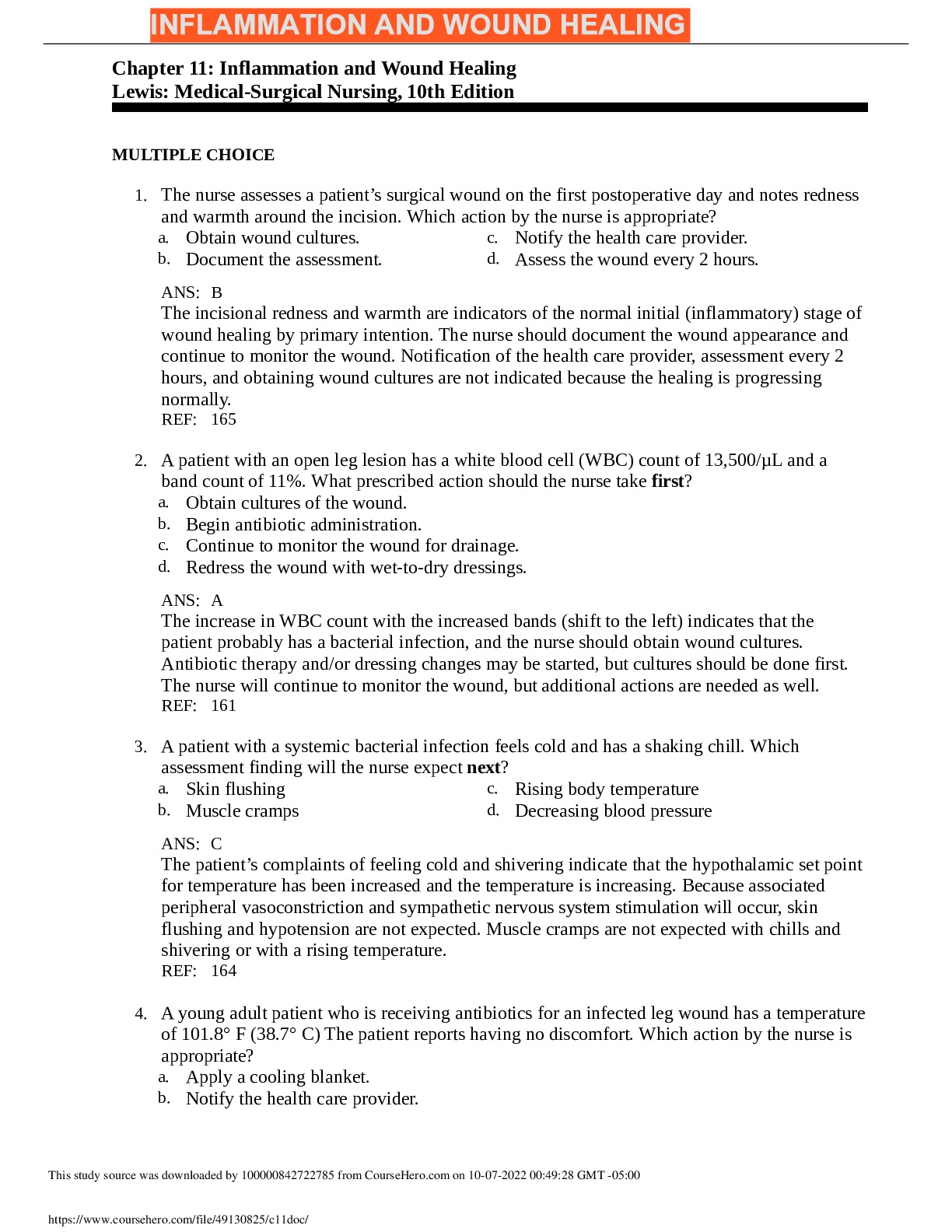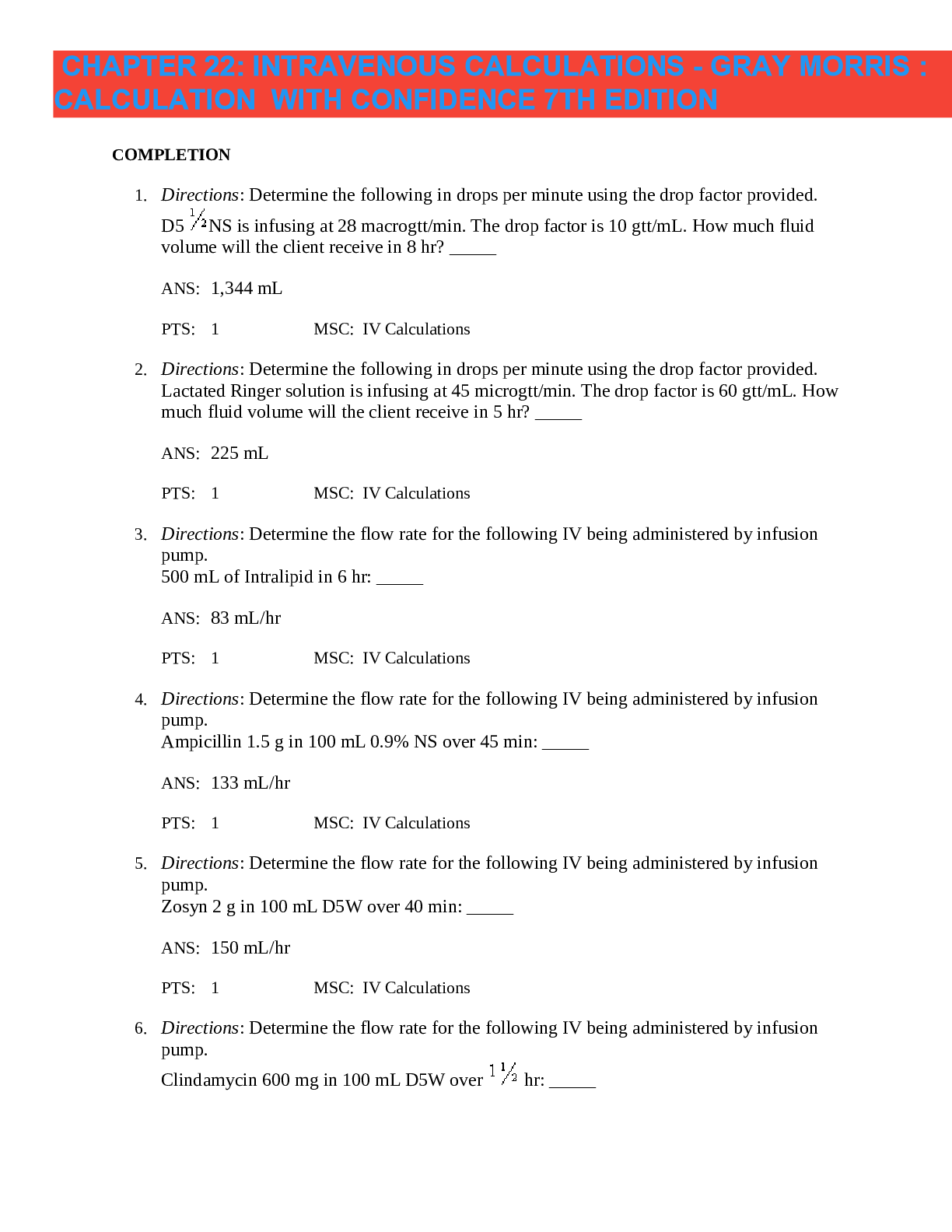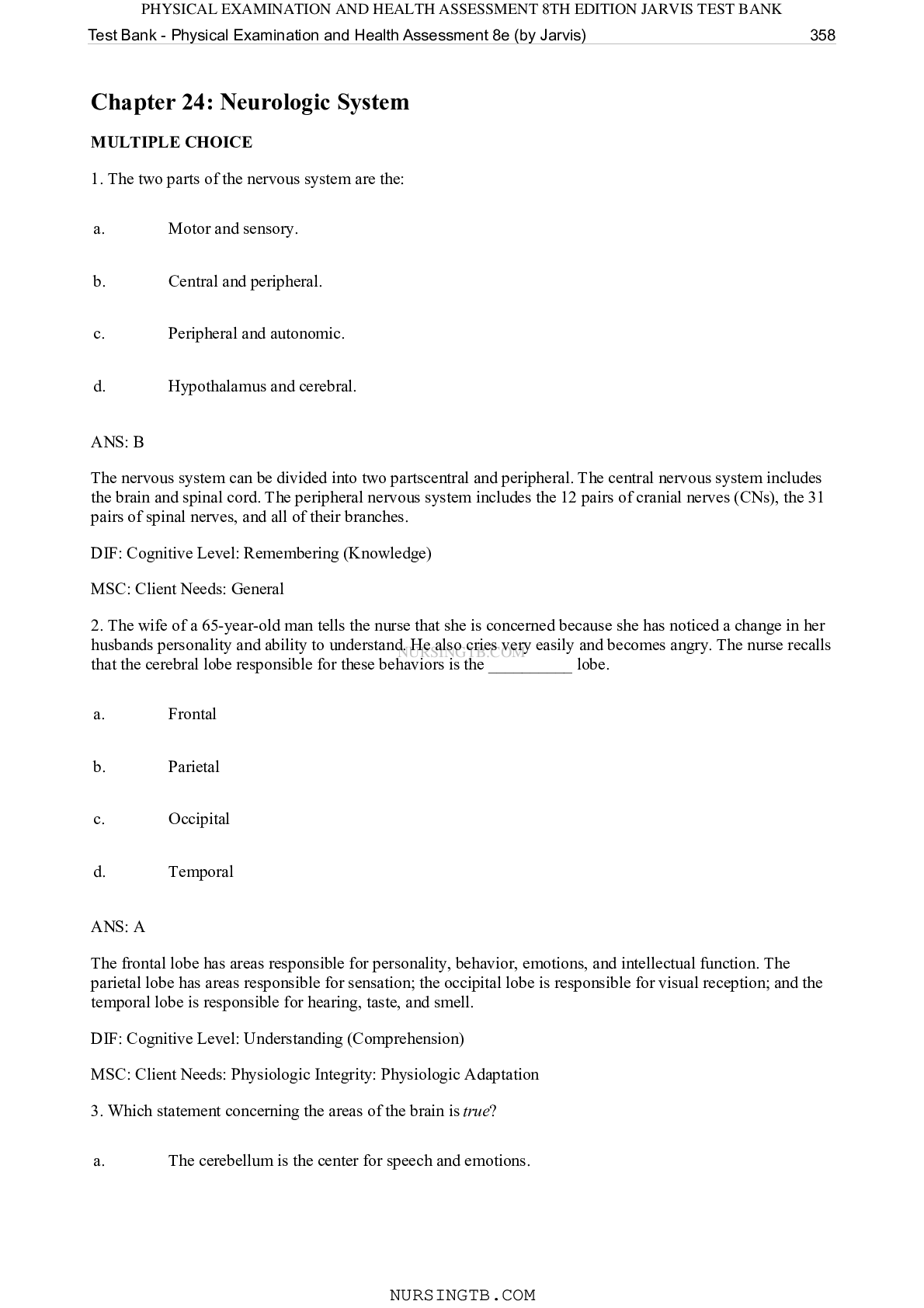*NURSING > QUESTIONS & ANSWERS > SOLVED!!! NR 509 COMPREHENSIVE REVIEW OF JARVIS 7TH EDITION CHAPTER 11 QUESTIONS ( Nutritional Asses (All)
SOLVED!!! NR 509 COMPREHENSIVE REVIEW OF JARVIS 7TH EDITION CHAPTER 11 QUESTIONS ( Nutritional Assessment: Physical Examination & Health Assessment)
Document Content and Description Below
SOLVED!!! NR 509 COMPREHENSIVE REVIEW OF JARVIS 7TH EDITION CHAPTER 11 QUESTIONS ( Nutritional Assessment: Physical Examination & Health Assessment) ◇This material contains comprehensive summary of... information in the form of great test questions with descriptive answers helpful for exams study. Thorough Review of Jarvis 7th Edition Chapter 11 Questions. All the best Champions! ______ Chapter 11: Nutritional Assessment Jarvis: Physical Examination & Health Assessment, 7th Edition MULTIPLE CHOICE 1. The nurse recognizes which of these persons is at greatest risk for undernutrition? a. 5-month-old infant b. 50-year-old woman c. 20-year-old college student d. 30-year-old hospital administrator ANS: A Vulnerable groups for undernutrition are infants, children, pregnant women, recent immigrants, persons with low incomes, hospitalized people, and aging adults. DIF: Cognitive Level: Remembering (Knowledge) REF: p. 181 MSC: Client Needs: Health Promotion and Maintenance 2. When assessing a patient’s nutritional status, the nurse recalls that the best definition of optimal nutritional status is sufficient nutrients that: a. Are in excess of daily body requirements. b. Provide for the minimum body needs. c. Provide for daily body requirements but do not support increased metabolic demands. d. Provide for daily body requirements and support increased metabolic demands. ANS: D Optimal nutritional status is achieved when sufficient nutrients are consumed to support dayto-day body needs and any increased metabolic demands resulting from growth, pregnancy, or illness. DIF: Cognitive Level: Remembering (Knowledge) MSC: Client Needs: Health Promotion and Maintenance REF: p. 181 3. The nurse is providing nutrition information to the mother of a 1-year-old child. Which of these statements represents accurate information for this age group? a. Maintaining adequate fat and caloric intake is important for a child in this age group. b. The recommended dietary allowances for an infant are the same as for an adolescent. c. The baby’s growth is minimal at this age; therefore, caloric requirements are decreased. d. The baby should be placed on skim milk to decrease the risk of coronary artery disease when he or she grows older. ANS: A Because of rapid growth, especially of the brain, both infants and children younger than 2 years of age should not drink skim or low-fat milk or be placed on low-fat diets. Fats (calories and essential fatty acids) are required for proper growth and central nervous system development.DIF: Cognitive Level: Applying (Application) REF: pp. 181-182 MSC: Client Needs: Health Promotion and Maintenance 4. A pregnant woman is interested in breastfeeding her baby and asks several questions about the topic. Which information is appropriate for the nurse to share with her? Breastfeeding is best when also supplemented with bottle feedings. a. b. Babies who are breastfed often require supplemental vitamins. c. Breastfeeding is recommended for infants for the first 2 years of life. d. Breast milk provides the nutrients necessary for growth, as well as natural immunity. ANS: D Breastfeeding is recommended for full-term infants for the first year of life because breast milk is ideally formulated to promote normal infant growth and development, as well as natural immunity. The other statements are not correct. DIF: Cognitive Level: Applying (Application) MSC: Client Needs: Health Promotion and Maintenance 5. A mother and her 13-year-old daughter express their concern related to the daughter’s recent weight gain and her increase in appetite. Which of these statements represents information the nurse should discuss with them? a. Dieting and exercising are necessary at this age. b. Snacks should be high in protein, iron, and calcium. c. Teenagers who have a weight problem should not be allowed to snack. d. A low-calorie diet is important to prevent the accumulation of fat. ANS: B After a period of slow growth in late childhood, adolescence is characterized by rapid physical growth and endocrine and hormonal changes. Caloric and protein requirements increase to meet this demand. Because of bone growth and increasing muscle mass (and, in girls, the onset of menarche), calcium and iron requirements also increase. DIF: Cognitive Level: Applying (Application) MSC: Client Needs: Health Promotion and Maintenance 6. The nurse is assessing a 30-year-old unemployed immigrant from an underdeveloped country who has been in the United States for 1 month. Which of these problems related to his nutritional status might the nurse expect to find? a. Obesity b. Hypotension c. Osteomalacia (softening of the bones) d. Coronary artery disease ANS: C General undernutrition, hypertension, diarrhea, lactose intolerance, osteomalacia, scurvy, and dental caries are among the more common nutrition-related problems of new immigrants from developing countries. DIF: Cognitive Level: Applying (Application) MSC: Client Needs: Health Promotion and Maintenance REF: p. 183 REF: p. 182 REF: p. 1817. For the first time, the nurse is seeing a patient who has no history of nutrition-related problems. The initial nutritional screening should include which activity? a. Calorie count of nutrients b. Anthropometric measures c. Complete physical examination d. Measurement of weight and weight history ANS: D Parameters used for nutrition screening typically include weight and weight history, conditions associated with increased nutritional risk, diet information, and routine laboratory data. The other responses reflect a more in-depth assessment rather than a screening. DIF: Cognitive Level: Applying (Application) MSC: Client Needs: Health Promotion and Maintenance 8. A patient is asked to indicate on a form how many times he eats a specific food. This method describes which of these tools for obtaining dietary information? Food diary a. b. Calorie count c. 24-hour recall d. Food-frequency questionnaire ANS: D With this tool, information is collected on how many times per day, week, or month the individual eats particular foods, which provides an estimate of usual intake. DIF: Cognitive Level: Remembering (Knowledge) REF: p. 184 MSC: Client Needs: Health Promotion and Maintenance 9. The nurse is providing care for a 68-year-old woman who is complaining of constipation. What concern exists regarding her nutritional status? a. Absorption of nutrients may be impaired. b. Constipation may represent a food allergy. c. The patient may need emergency surgery to correct the problem. d. Gastrointestinal problems will increase her caloric demand. ANS: A Gastrointestinal symptoms such as vomiting, diarrhea, or constipation may interfere with nutrient intake or absorption. The other responses are not correct. DIF: Cognitive Level: Applying (Application) REF: p. 182 MSC: Client Needs: Health Promotion and Maintenance 10. During a nutritional assessment, why is it important for the nurse to ask a patient what medications he or she is taking? a. Certain drugs can affect the metabolism of nutrients. b. The nurse needs to assess the patient for allergic reactions. c. Medications need to be documented in the record for the physician’s review. d. Medications can affect one’s memory and ability to identify food eaten in the last 24 hours. REF: p. 184ANS: A Analgesics, antacids, anticonvulsants, antibiotics, diuretics, laxatives, antineoplastic drugs, steroids, and oral contraceptives are drugs that can interact with nutrients, impairing their digestion, absorption, metabolism, or use. The other responses are not correct. DIF: Cognitive Level: Understanding (Comprehension) MSC: Client Needs: Health Promotion and Maintenance REF: p. 186 11. A patient tells the nurse that his food simply does not have any taste anymore. The nurse’s best response would be: a. “That must be really frustrating.” b. “When did you first notice this change?” c. “My food doesn’t always have a lot of taste either.” d. “Sometimes that happens, but your taste will come back.” ANS: B With changes in appetite, taste, smell, or chewing or swallowing, the examiner should ask about the type of change and when the change occurred. These problems interfere with adequate nutrient intake. The other responses are not correct. DIF: Cognitive Level: Understanding (Comprehension) MSC: Client Needs: Health Promotion and Maintenance REF: p. 185 12. The nurse is performing a nutritional assessment on a 15-year-old girl who tells the nurse that she is “so fat.” Assessment reveals that she is 5 feet 4 inches and weighs 110 pounds. The nurse’s appropriate response would be: a. “How much do you think you should weigh?” b. “Don’t worry about it; you’re not that overweight.” c. “The best thing for you would be to go on a diet.” d. “I used to always think I was fat when I was your age.” ANS: A Adolescents’ increased body awareness and self-consciousness may cause eating disorders such as anorexia nervosa or bulimia, conditions in which the real or perceived body image does not favorably compare with an ideal image. The nurse should not belittle the adolescent’s feelings, provide unsolicited advice, or agree with her. DIF: Cognitive Level: Applying (Application) MSC: Client Needs: Health Promotion and Maintenance 13. The nurse is discussing appropriate foods with the mother of a 3-year-old child. Which of these foods are recommended? a. Foods that the child will eat, no matter what they are b. Foods easy to hold such as hot dogs, nuts, and grapes c. Any foods, as long as the rest of the family is also eating them d. Finger foods and nutritious snacks that cannot cause choking ANS: D Small portions, finger foods, simple meals, and nutritious snacks help improve the dietary intake of young children. Foods likely to be aspirated should be avoided (e.g., hot dogs, nuts, grapes, round candies, popcorn). [Show More]
Last updated: 2 years ago
Preview 1 out of 11 pages

Buy this document to get the full access instantly
Instant Download Access after purchase
Buy NowInstant download
We Accept:

Reviews( 0 )
$15.00
Can't find what you want? Try our AI powered Search
Document information
Connected school, study & course
About the document
Uploaded On
Sep 12, 2021
Number of pages
11
Written in
Additional information
This document has been written for:
Uploaded
Sep 12, 2021
Downloads
0
Views
98





.png)
.png)
.png)
.png)

.png)





.png)

.png)



